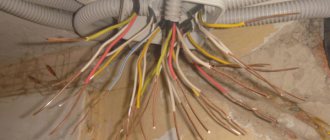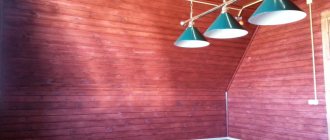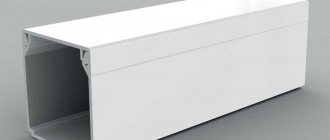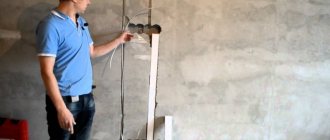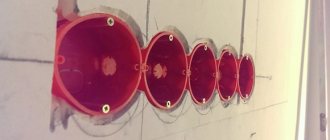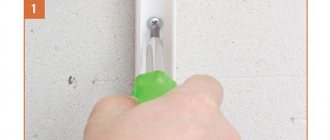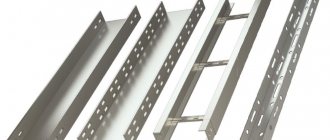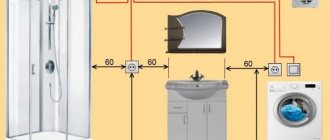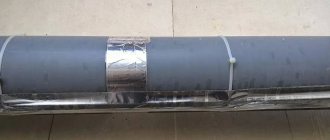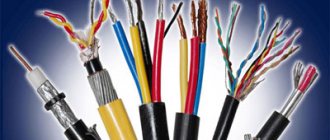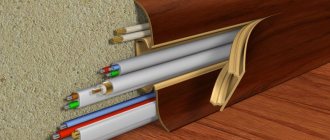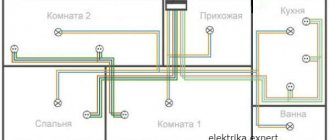There are many materials and components on the construction market for proper installation of communications. Let's consider what cable channels for electrical wiring are: types, types and sizes. Read to the end and you will find out how you can use certain products, what may be required for the installation and arrangement of a branched system in accordance with the requirements of current regulatory documents.
Variety of cable boxes and components Source s13.buyreklama.ru
Why do you need a cable channel?
The main purpose of hollow products is the free placement of conductive communications. If the wiring in the room is installed in an open way, then the boxes additionally serve a decorative role. There are types of cable channels that are intended only to support multi-channel lines (for example, in warehouses, shopping centers). Thanks to the boxes, hidden wires in certain structures can be removed and replaced without destroying the base.
In addition to the above, products with covers protect the network from environmental influences (moisture, mechanical stress). Since electricity can cause a fire, cable channels are installed to prevent the fire of adjacent structures, decorative finishes and surrounding objects. If the channels are installed correctly, the internal space becomes isolated from oxygen, which contributes to the rapid attenuation of damaged wiring.
Sample with a hermetically sealed lid Source sakh.com
Based on the PUE (clause 2.1.61), in boxes with a removable lid the fill limit of the internal space is 40%, in sealed trays the figure is 35%. If the thresholds are exceeded, the likelihood of overheating of the current-carrying conductors and melting of the protective sheath increases. There are several solutions in this case. You can take a larger cable channel in size and characteristics, or an additional tray, or take products with perforations. But it’s better to stick with the first options.
The degree of security of the internal space of the closed tray is considered separately. Typically, there are three options. IP 20 is typical for channels with a perforated base, IP 40 for a solid base. If you need to place the wiring in a damp room, you will need boxes with an IP rating of 44.
Corner
Cable channels with a corner-type cover often serve as decorative components when arranging walls and ceilings. They are attached at the junction. A sufficient number of conductors can be placed inside.
But compared to other types, corner models are less spacious (the popular size is 40x40 mm), and their walls are prone to damage due to their thinner design.
Special trays for LED strips are made in the same way. True, their top cover will be transparent. Installation is carried out under the ceiling or on the surface of kitchen cabinets.
Briefly about open installation of power supply
External installation of electrical networks today is performed less often than hidden installations. This is explained by the use of modern durable materials and aesthetic considerations.
Combining retro wiring and cable ducts with open installation Source izhevsk.ru
However, open installation also has its advantages:
- work is completed faster;
- walls, floors and ceilings remain intact;
- no tool required to form grooves;
- it is possible to carry out repairs or make any changes without destroying the finish;
- monitoring the condition of the electrical network and timely detection of faults is easier than with hidden wiring.
In addition to the unattractiveness of the open arrangement of wires that attract attention, the disadvantages include the need to comply with fire safety and technical standards. Here, the optimal solution is cable channels in one design or another. You can resort to a retro style, but then the estimate will be increased due to the need to use special network insulating products.
Ceramic bushing for twisted wiring Source svetotehnica.ru
Skirting
These types of cable channels allow you to quickly lay the cable without the need to violate the integrity of the walls or cause damage to them. The advantage is not only the color variety, thanks to which you can choose a design that best suits the interior design style, but also the complete set of auxiliary devices.
To simplify mounting, you can purchase corners for internal and external mounting, various bends, and plugs. Often, mounting or multimodule type boxes are purchased as a kit. They have sockets and even switches. This solution makes it possible not to focus on the wiring, but creates some inconvenience for older people when accessing connection points.
White, gray and black boxes are sold, as well as wood or metal samples. There are also a variety of standard sizes, but this design is not cheap.
Assortment within the group of building materials
To choose the right cable channel, you need to find out what sizes and design are available. The location of a particular box or sleeve, the permissible number and cross-section of conductors depend on this. The material has different strengths and resistance to different operating conditions. Let us consider in more detail each criterion and the corresponding types of building materials.
What is the channel made of?
The leading position here is held by metal and plastic. The first one is more often considered for installation on large objects where communications are visually hidden. The latter are relevant for the private sector, social, administrative and public institutions.
Ceramic products fit well into retro-inspired designs, but are expensive and heavy. Compared to their analogues, they are less practical due to their fragility.
Plastic
This is the most popular option due to its wide range, light weight and low cost. The materials used for production are polyvinyl chloride, plastic and other polymer products with special functional additives.
Plastic channel with a triangular cross-section Source lampadia.ru
Finished products must meet the following requirements:
- low coefficient of thermal expansion;
- resistance to mechanical load;
- inertness to biological activity and chemical reagents (household detergents or aggressive indoor environment);
- fire resistance (but in rooms with explosive and flammable substances it is not recommended for use due to the release of toxic melting products);
- preservation of color and shape under the influence of ultraviolet radiation.
Various types of products are easily formed from polymer raw materials, which makes it possible to produce cable channels for electrical wiring in a wide range. This applies to shape, color, design (perforation, cast longitudinal partitions and stiffeners).
Sample with perforated walls Source cdnmedia.220-volt.ru
The products can be used as wall, ceiling and floor cable ducts, decorative and architectural elements, separators for conductive lines for various purposes and power (power, low-current).
In addition to weight and price tag, the advantages of such solutions include:
- wide range of operating temperatures (from -32 to +90 degrees Celsius);
- inertness to various types of corrosion processes;
- simple installation (it is permissible to use self-tapping screws, metal or plastic brackets, glue or double-sided tape);
- cutting is carried out using improvised tools (construction knife, hacksaw, hot metal blade);
- minimal care (moistened and dry wipe, coloring possible if desired).
The cover for the plastic cable channel is made with longitudinal edges that are shaped like a groove. They are put on the reciprocal “spikes” of the tray. It is permissible to remove the strip and close the box multiple times.
A simple double lock for closing the box Source planeta-electro.com
See also: Catalog of companies that specialize in electrical work of any complexity
Metal
This material has three main advantages: mechanically high strength, resistance to aggressive operating conditions, fire resistance (plus there are no emissions harmful to health when heated). These characteristics of the cable channel expand the scope of application including outdoor installation. For the production of engineering trays, various types of galvanized steel and anodized aluminum are used. Here the product requirements include the following:
- resistance to phenomena that provoke corrosion processes;
- endurance to designed loads (mechanical, temperature, humidity, chemical);
- non-conductivity of electromagnetic rays (relevant for communication devices for warning and video surveillance systems).
For the most part, metal trays are made with a cross-section in the shape of a square or rectangle. Solid channels are used for installation on a combustible base. In other cases, experts give preference to products with perforations for fasteners or natural air circulation.
Metal cable tray with perforation Source yandex.net
The lid, similar to the box, is made with curved longitudinal edges. Closing is carried out by snapping the strip onto the walls of the tray. The procedure can be performed many times, which allows you to operate cable channels for electrical wiring longer than plastic counterparts. This is justified by the ability of polymer products to wear out, crack and deform.
The table presents a comparative description of polymer and metal samples according to basic criteria.
| Criterion | Aluminum | Steel | Polymer |
| Variety of sizes | + | + | + |
| Accessories | + | + | + |
| Laying different conductors | + | + | + |
| Pulling highways | + | + | + |
| Box | + | + | + |
| Corrugation | — | + | + |
| For production | + | + | — |
| For social facilities | + | — | + |
Since the weight of the metal is relatively large, to fix them you need to use hardware, anchors, dowels or special brackets. This fact conventionally refers to the disadvantages of metal structures. But the complexity here is limited to the use of a drilling tool.
Product design
Electrical wiring lines are placed based on building codes and regulations, taking into account the convenient location of sockets with switches. Points can be mounted on walls, ceilings, floors in any part of the plane. Each of the options involves ensuring the protection of communications, free access to conductors, and the safe movement of people and pets. In pursuit of these and other tasks, manufacturers offer for consideration a variety of types of cable channels for electrical wiring according to the type of design solution. The advantages and disadvantages of the main options are discussed in the table.
| Form | Advantages | Flaws |
| Box | Strict geometry with right angles, it is possible to install longitudinal partitions, and can be easily installed almost anywhere. They are available in cross section: square, rectangular, triangular. | Due to the rigidity of the tray, it is difficult to ensure a tight fit of the channel on a curved base (plane or angle). The decorative component is limited by the size of metal or plastic cable channels, color or pattern. |
| Corrugation | The flexible circular channel allows lines to be laid inside and on top of structures in any conditions regarding levelness and access. Conductor replacement is carried out using a metal rod in a short time without dismantling walls, floors or wire ducts. Fastening is carried out using plumbing clips, clamps or ties without compromising the integrity of the sleeve. | There is no cover, which eliminates the possibility of inspecting or replacing the wiring in a separate area without cutting the corrugation. |
| Parapet | Here, manufacturers combined two types of cable channels: ducts and plinths. They are installed at a height of 80-100 cm from the floor, the space allows you to place several conductors. The trays fit well into the interior of medical, public and office institutions. | Narrow boxes have a large width, which is difficult to combine with home design (with the exception of the Loft style). |
| Pipe | Technically, the products are similar to conventional plumbing pipes for sewerage installations. They are easy to disguise against the background of other pipe communications, mounted at a distance from the base, they weigh little and are easy to install. | The disadvantages boil down to the need to disassemble the channels to perform local wiring repairs. It is difficult to completely replace lines with a large number of turns. The system is assembled using component connectors. |
| Skirting | The products perform two main tasks: masking current-carrying conductors and the installation joint between walls and floor coverings. As a rule, the TV cable and Internet conductor are placed here. The range is presented in various colors and patterns. | For a cable channel, products are considered expensive, but this is compensated by their functionality. The main disadvantage can be considered the small usable space. |
| Threshold | Here the lid is made in the shape of a hemisphere, which completely covers the cable channel. This allows the products to be used as thresholds, making it impossible to trip over them. | Depending on the degree of cross-country ability, it is necessary to pay attention to the mechanical strength of the product (reinforced plastic with stiffeners or aluminum). |
| Net | This is the most inexpensive option that does not require cleaning and is attached in any convenient way. Steel wire is used for production. It does not attract dust, is resistant to high mechanical loads, is not afraid of moisture and weighs little. The cellular design provides natural ventilation and open access to check the network at any time. | It is not relevant for home interiors due to the lack of decorative components and transparency. There is no protective function against temperature and humidity changes. |
| Ladder | Reinforced version of cable channels. It is made of a metal profile with different sections with a U-shape. Used for pulling power cables and a large number of lines. | It weighs more than other samples, does not have a cover, and does not protect current-carrying lines from environmental conditions. |
Several more varieties are considered separately. Box-type mini channels are compact and can accommodate one conductor of small cross-section. The smallest size of such a cable channel is 12*7 mm. Flexible, rectangular rigid plates are used to protect wires that are laid on the floor and uneven surfaces. With transparent covers, products are used to mask and protect both conductive lines and LED-illuminated strips.
Samples with translucent lid Source myshoptet.com
No. 1. Basic selection options
A cable channel is a special hollow structure with space for electrical wires. The product consists of a tray, which is installed on the surface of a wall, floor or ceiling, and a lid. There are boxes with a slightly different design, but this is the most common. Cable channels can also be used to lay telephone, Internet and television lines; they are often used to disguise air conditioner wires. In large offices, where it is necessary to provide each workplace with electricity, the Internet and a telephone line, cable channels are completely irreplaceable.
When it is not possible to hide wiring in the wall, a cable channel is a real salvation. The main advantages of such a solution are:
- protection of wiring from ultraviolet radiation and mechanical influences;
- increasing the fire safety of the premises, although many are ready to dispute this point, because the cable channel is a closed space, and the wires certainly heat up, i.e. the heat remains inside the structure, which means the risk of ignition is much higher than when laying the wire without protection. But it is also worth considering the fact that the cable channel is a sealed structure, there is almost no oxygen supply, so the fire will not be able to spread, and the ignition will go out. In addition, there are perforated channels, which, due to the influx of fresh air, cool heated cables;
- the ability to instantly replace the wire or lay a new branch. If the cable is in the wall, then any manipulation will lead to serious damage;
- the ability to lay several wires in one channel, incl. different types, such as wiring and telephone lines. For these purposes, there are special designs with internal partitions;
- quick installation of electrical wiring.
as a disadvantage , since a plastic channel running along the wall is unlikely to decorate the room, but everything is learned by comparison. A neat cable channel is clearly much better than a hanging bundle of wires. If we take into account the presence of numerous modifications of the channels, the wiring can be made almost invisible. There are products that are indistinguishable from ceiling or floor plinths, there are models painted to look like wood - there are a lot of options, however, such solutions with increased aesthetics are more expensive than the simplest products made of white plastic.
The disadvantages include the fact that the cable takes up a little space. Yes, often such a loss does not bring any inconvenience, but there are times when every centimeter counts. In addition, high-quality wiring using cable channels is only possible when using a large number of auxiliary elements, i.e. In addition to the channel itself, tees, corners, etc. will be needed. Please also take into account the fact that a protruding element on a wall or floor can easily get caught and damaged.
When choosing a cable channel for electrical wiring, consider the following factors:
- material of execution , which affects the level of durability, strength and fire resistance;
- design features . The cable channel can have a rectangular, angular or semicircular cross-section, it can be flexible or lattice - there are a lot of variations, each will be indispensable in a given situation, and we will consider each type further;
- features of the room where the wiring is being laid. For example, a channel for a wooden house must meet increased fire safety requirements, but for moving structures it is unacceptable to use stationary cable channels;
- appearance . Aesthetics are important for residential premises, so the color and shape of the cable play an important role;
- size . The more wires you need to hide, and the larger their cross-section, the larger the cable channel will be needed, but we will return to this later.
Recommendations from experts
Often mistakes are made during installation work. They lead to the need to make adjustments to the project or increase the estimate for consumables. To exclude this, you need to familiarize yourself with the reasons for such troubles:
- the markings are applied without taking into account the reserve for the component elements (you have to do it end-to-end, which does not always work out well);
- fasteners and materials were selected without taking into account the features of the architectural part of the room (shape, evenness, density, structure);
- useful space is filled exceeding the permissible 35 or 40%;
- the type of cable channel was not selected in accordance with the operating conditions (characteristics of conductors, climate, mechanical load, aggressiveness of the environment);
- a flexible hose or strip is mounted under tension.
To avoid mistakes and waste of materials, specialists begin work by drawing up or familiarizing themselves with project documentation.
Example of a layout of cable ladders Source baks.com.pl
To implement the planned actions, only high-quality products from trusted manufacturers are used. You can check them as follows:
- absence of defects (cracks, deformation, burrs, scratches and uneven coloring);
- strict geometry, precision of execution relative to the relief and end edges;
- ease of opening and tight closure of the lid without the appearance of defects (it is better to check at the point of sale several times).
Some craftsmen recommend paying attention to the range and quality of components (including color or pattern matching). It is believed that a good manufacturer approaches this issue with full responsibility. It is worth giving preference to such products.
Types of devices
Electrical trays are produced in the form of two-meter strips, differing in cross-section and dimensions of the internal cavity. This variety allows you to select the desired tray width for each type of cable and their quantity. You won't have to use products that are too narrow or too wide.
The standard sizes of cable channels are: 2x12, (16 or 25)x16, 25x25, 40x(16 or 25), (60 or 80)x40, 80x(40 or 60), 100x60. Some manufacturers may offer samples in other sizes. There are features in the shape and dimensions of some species that have a specific purpose in use.
Briefly about the main thing
Cable channels are used for careful installation of open-type electrical communications, protecting wires from various factors, ensuring safety for humans and pets.
The choice of products involves consideration of several criteria: degree of protection and capacity of the internal space, structural and decorative design, material.
It is important to take into account the permissible fill rates for a tray or channel with a round cross-section: 35% for sealed products, 40% for boxes with a lid.
In the residential sector, as a rule, skirting boards, thresholds, plastic boxes and corrugated sleeves are used.
For ease of installation and aesthetics, it is worthwhile to additionally use components: tees, straight and corner connectors, plugs, various blocks.
Floor-standing
Their use is not so much aesthetic as functional. The design is used when it is necessary to connect wiring, for example, to a desktop or to the opposite side of the room.
- SIP wires: types, differences from cable, features and advantages
What is a Power Cable?
- How to conveniently unwind a cable coil on site during electrical installation
The boxes are mounted on the floor, and therefore one of the horizontal sides has a rounded shape to eliminate inconvenience when moving a person. You won't need to use extension cords or special carriers.
For joints, various shaped angles, joining inserts, and turn signals are used. When fastening, the base is placed, then the cable is placed, and the cover is attached on top.
The fastening devices snap easily and provide the required degree of protection, as can be seen in the photo of the cable channels. Among the sizes you can choose options 50x12; 75x17; 92x20 and 160x65 mm in gray, white and black.
Selection of electrical cable cross-sections
The cross-section of electrical cables is selected based on the power of existing electrical energy consumers. It is especially worth highlighting the following requirements for selecting the cross-sectional area of electrical cables:
- for lighting devices, it is necessary to use an electrical cable with a cross-sectional area of approximately 1.5 square meters. mm;
- for sockets it is necessary to use an electrical cable having a cross-sectional area of approximately 2.5 square meters. mm.
- for energy consumers with increased power (for example, an electric furnace), it is more correct to use an electrical cable with a large margin for the passage of electric current - 4 kW. mm.
The most complete and detailed information on the requirements for selecting cross-sectional area and the brands of electrical cables used can be obtained from the regulatory technical base.
It is also worth noting that an increase in the cross-sectional area of an electrical cable affects an increase in its cost, thus, the “more, just in case of fire” approach often used by consumers is meaningless. Organization of electrical wiring in the baseboard space.
The arrangement of electrical cables in baseboards has a certain disadvantage, namely that the small volume of the cable channel inside the baseboard is not enough to accommodate more than three electrical wires of average diameter, although in most cases this volume is more than enough. Otherwise, laying wiring in skirting boards is very convenient, and the room is less cluttered with various structures, while maintaining its original design and concept.
Dimensions and components
PVC is used for the production of corrugated plastic pipes. Most often, products with an internal diameter from 16 to 32 mm are used, but when choosing, you must additionally pay attention to the purpose of the corrugation - it can be light or heavy.
The first are standard products that are used for installing electrical circuit lines inside buildings. Heavy corrugations provide more solid protection and can be used outdoors, and in some cases, under water.
Since in long highways it is not always possible to push a wire through a pipe without auxiliary parts, additional corrugations can be equipped with probes made of metal single-core “steel”, however, installers usually have their own.
Dimensions of corrugated pipes for cable:
| Heading | Outer diameter, mm | Inner diameter, mm |
| Corrugated PVC pipe without probe | 16 | 10,7 |
| 20 | 14,1 | |
| 25 | 18,3 | |
| 32 | 24,3 | |
| 40 | 31,2 | |
| 50 | 39,6 | |
| 63 | 5,6 | |
| Corrugated PVC pipe with probe | 16 | 10,7 |
| 20 | 14,1 | |
| 25 | 18,3 | |
| 32 | 24,3 | |
| 40 | 31,2 | |
| 50 | 39,6 | |
| 63 | 50,6 |
Advantages of plastic corrugated pipes
- Indispensable for laying wires on uneven surfaces or when it is necessary to make frequent turns in the highway.
- Usually sealed along the entire length, therefore they reliably protect the wires from high humidity.
- Additional protection of cables from mechanical damage and people from electric shock.
- Clip-on mounting is one of the easiest to install and maintain - you can insert or remove the corrugation from them without additional tools.
- In addition to fire safety, the plastic from which the corrugation is made contains additives that prevent combustion. When the wiring is shorted, the corrugation will not flare up, but will simply melt.
Cons of plastic corrugated pipes
- They do not tolerate negative temperatures well - when overcooled, they lose elasticity and break, so they are more suitable for interior work.
- If there are too many turns and bends, pulling the cable inside the corrugation will be very difficult and sometimes impossible, so you will have to first pull the wires inside and then carry out the general installation.
Metal
They can be solid, perforated or wire. Channels are popular when installed in walls made of combustible materials. In this case, boxes are mounted in the walls or ceilings, a cable is placed in them, which is taken out in the right place. But for suspended and suspended ceiling structures, it is advisable to use wire modifications. For such trays, only a few hangers are attached with quick laying of wires.
These are metal structures with a strip length of up to 3 m. The width varies in the range of 50-600 mm, and the height – in the range of 50-100 mm.
- Wire connector: instructions on how to make the connection yourself. Instructions for use of clamp, clamp and lugs
Wire lugs: instructions on how to select and install a lug. Overview of all types, photos, instructions, diagrams
Heat shrink for wires: all types and characteristics. Detailed description of how to choose and use heat shrink
Fastening methods
Attaching the cable to the wall is done in various ways. The choice of a specific option depends on the composition of the working surface. The materials used and work with them are discussed in the table.
| Fastening method | Operating procedure, tips | Mounting surface |
| using self-tapping screws | wood screws are screwed in with a screwdriver on average every 50 cm; It is recommended to use them with a length of about 40 mm; used for quick installation of plastic channels; no pre-drilling required | |
| dowel-nails (quick installation) | the lid is removed from the box; holes are drilled in it in increments of about 45 cm; it is adjusted to the surface, marking the location of the drilling points on it; use a hammer drill to make a hole in the wall; the plastic part of the nail is inserted through the box into the hole, the metal part is then hammered in | allows you to securely attach it to a concrete wall, brick, stone |
| "bugs" | screwed with a screwdriver through the distance indicated above | thin metal (less than 2 mm) |
| glue (liquid nails) | apply the adhesive inside out the prepared section; lean it against the marked place for a few seconds, move it away; wait for the glue to thicken; pressed back; additionally it is required to use dowels and screws | wood, drywall, wallpaper, tiles, can also be glued to a concrete surface |
The step width is adjusted based on surface unevenness. For more information on how to select and install a cable channel, watch this video:
The first 3 methods provide the ability to dismantle the elements intact, and the 4th - only with fragments of finishing. The installed box looks great only on smooth walls.
It is recommended to install wiring in the cable channel after all finishing work has been carried out (pasting wallpaper, applying decorative plaster).
With this method of laying lines, the rules of the PUE are observed, and you can easily get to the place of the problem.
The presented fastening options reliably join the surfaces. The variety of materials fits the laid routes into the apartment’s decor.
What are they for?
Cable channels for laying open electrical wiring are the simplest box-shaped or tubular devices used to solve the following problems:
- Compact placement of power and signal conductive elements.
- Protecting conductors from damage, preventing cases of electric shock to people.
- Localization of electrical fires. PVC is a certified material from which these structures are made that does not support combustion.
- Hiding electrical and signal lines, giving them an aesthetic appearance.
Wire quality
It is worth remembering that the reliability of hidden, and indeed any, wiring depends not least on the quality of the wire. Today you can find a large assortment of conductors on the market. Their main parameters are as follows:
- the cross-sectional diameter of the core can be from 800 to 0.75 mm;
- core material (most often copper, aluminum or their alloy);
- number of cores up to 37;
- wire sheath: yarn, rubber, paper, plastic (more protected wires have two types of insulation).
For installation of wiring at home, cables marked NUM and VVG are used, as well as wires SHVVP, PUNP and a number of others. It is worth briefly talking about the main features.
VVG is a cable without armor, the cores of which are copper and the insulation is vinyl. There are several varieties on the market with additional markings: VVG NG has increased fire safety, VVG Z has additional insulation, etc.
NUM is a high-strength cable for organizing hidden wiring. Poorly suited for outdoor wiring, since the outer shell has poor resistance to sunlight.
PVS – connecting wire for any type of work.
PBGPP and PBPP – wires for laying lighting lines. They differ in the presence of an additional flexible core.
ShVPP is a copper wire of increased flexibility.
In general, making hidden wiring at home with your own hands is a difficult task, but quite accessible even to a non-specialist. The main thing here is to strictly observe the technology features and nuances described above, and then high-quality wiring will delight you for many years.
Place of installation - floor, partition, ceiling
Separately, it should be noted the options when hidden electrical wiring is installed in floors, ceilings or partitions. For example, if we are talking about a suspended ceiling made of plasterboard with a metal frame, then it will be much easier to hide the wiring; you don’t even need to ditch the walls - the conductors are simply hidden under the ceiling, and go down at the right points.
You can also place junction boxes under the drywall, but for them you will have to worry about installing hatches opposite. Hatches are used to gain access to hidden wiring if necessary. Clamps or UW are used to secure lighting cables to the ceiling covering.
The best option: hidden electrical wiring is first hidden in pipes, and they are already mounted in the ceiling. This solution makes it possible to increase the fire safety of a plasterboard structure; installation is carried out using clips.
Installation of hidden electrical wiring under the floor covering is carried out in a similar way. The easiest way to install cables in the floor is if it is made of wood or gypsum fiber. In the case of wood, holes are made in the logs into which pipes are inserted and the cable is laid accordingly. As an alternative, hidden wiring can be arranged along the floor surface. First, level the surface with expanded clay or a similar mixture, and apply a finishing coating on top.
Some install hidden electrical wiring in the apartment, hiding the wires in pipes and then filling them with cement. This should not be done, especially if it is planned that the layer of solution above the pipe will be small.
An important point: if you decide to hide the wiring under the floor or ceiling, connections may only be made in specially designed boxes. This is the only way, if it fails, it will be possible to get to it relatively quickly.
Often, hidden wiring is installed behind drywall and into partitions.
In an attempt to get by with minimal effort, holes are made in the metal profile itself. You should also not pull wires through the drywall before sewing it on. In both cases there is a high risk of damage to the insulation. Pulling out the conductor for repair becomes very problematic. This problem can be solved simply. Before pulling the conductors through the holes, you should first put them in pipes.
Working with lighting is much easier. The key role here is played by voids in the slabs. They remain from the floor installation stage. This solution is also attractive because it does not require any gating. However, this does not affect the protection of the cables. It is enough to punch two holes: at the wall and at the location of the lamp. To pull wire through pipes, special probes made of rigid wire are most often used.
It remains to note the case when hidden wiring is installed through insulation in the walls. It is preferable to lay through mineral wool due to the individual characteristics of the material: it is lightweight, has excellent compressibility and does not require any additional work. Many people prefer polystyrene foam, but additional channels for pipes will have to be cut into it.
